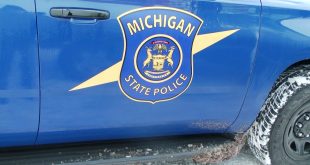The region’s two invasive Buckthorn Species are two of the KISMA’s biggest concerns each mitigation season. Keweenaw Invasive Species Management Area Coordinator Sigrid Resh says that the woody plant that was once used commonly in residential and municipal landscaping, out competes young native tree saplings and herbaceous species. Buckthorn also does not act as a typical food source for hatchlings because they cannot process the seeds.
“So they’re changing our forest canopy structure in the time that they’ve been here. And then also, because they don’t tend to feed our native wildlife, including our insects, which some people don’t think of as wildlife, but they do, they don’t tend to feed those as well. And the birds do eat the seeds. It’s well known that the birds that eat the seeds and nest in areas where there’s buckthorn. They cannot feed their young on the caterpillars that they need to feed their young with because the caterpillars, which are larvae of insects, don’t tend to use buckthorn. So while the seeds can provide food to the adult birds, that’s leaving the birds thinking this is good habitat. The birds can’t find enough food to feed their young and often we’re seeing decreases in the amount of surviving nestlings because of the lack of food.” – Sigrid Resh, Program Coordinator, KISMA
In the past KISMA has used Chondrostereum purpureum before removing buckthorn from the soil. With similar results to a study from British Columbia, KISMA had high hopes for the fungi’s potential use.
“And so we compared those results and found that it was almost as effective as the chemical approach. But it’s still a lengthy endeavor to have to either cut or girdle the stems. And then you also have a lot of buckthorn seed germination based on the removal of overstory if you’re doing cut stump. Because all that sun comes in and you have the seeds in the soil from previous seed drops. And so we realized that we could remove the overstory trees pretty successfully. But we still had this understory regeneration going on. And then that entered Abe. We pulled him in and he was super excited to take on this project. He’s always had a great interest in fungi. And so, we moved on to also trying that fungi on small whips or what would be, the seed germinants from buckthorn. And that’s, that’s where his story entered in as, but then he’s continued to test out new ways of applying new ways of not only culturing the fungi but new ways of possibly applying the fungi cultures to the stems to try to decrease the amount of effort that goes into applying both chemicals and this Chondrostereum purpureum.” – Sigrid Resh, Program Coordinator, KISMA
In steps Ecology and Evolutionary biology student Abe Stone, added Resh, whose keen curiosity in mushrooms sparked a new way to cultivate Chondrostereum purpureum for easier application.
“In terms of the experimentation that’s been a lot of really fun lab work over April and May, right before the big growing season hits and we have to put it on the buckthorn. A lot of the time has been spent in the lab kind of mixing a these concoctions of different ingredients to see how it affects the growth of the fungus and how much broth to put in, how much growth do we get we put a little bit of on if the bag ingredient called fumed silica which that will begin breaking the fungi apart as it grows. And through that we can get these tiny little balls or big balls. And all of them are different ways of making the inoculants. So I did a lot of that in the last year.” – Abe Stone, Ecology and Evolutionary Biology Student, Michigan Technological University
After a little experimentation using the Norwegian study’s method, Stone was able to cultivate a fungus solution that could be sprayed onto buckthorn. A major goal of using the fungus, as opposed to common chemical solutions was to limit the amount of native plant loss when working to weaken the buckthorn’s growth.
“It is a little bit challenging because the fungus that we’re working with likes to grow on trees. It’s not something that grows in water. So I had to try to figure out a way for it to grow had been kind of interesting but I ended up stumbling upon this cool paper that was written by people in Norway. In which they were able to do that. But they essentially made it, instead of growing fungus on something and then putting a bunch of water onto it and hoping that it lives when you spray it. They ended up putting it in an into what it is like a soup” – Abe Stone, Ecology and Evolutionary Biology Student, Michigan Technological University
Encouraging curiosity has always been a driving force behind professors and students working together at Michigan Tech.
“Like when Abe approached us, it was really easy to hand over this project because he was so excited and so full of his ideas and let him run with it. And then I have other students who don’t necessarily know exactly what they want to do, but they’re willing to try anything. So they’ll take ideas of mine and give things a try. I have students who are looking at if they don’t get all the roots of a species, how much of it would grow back. Or if can it grows back, how much of the root do you need to get? I’ve had students looking at knotweed and how much carbon gets reallocated from the above-ground full-grown plants to the below-ground portions of the plants during the year to look at when and how often I need to cut knotweed. turning it into a research project is part of what our university is meant to do, which is to give people experience and try things. So we have internal grant awards for students and some are undergraduate research fellowships, like what Abe started with. And they’re a great opportunity for students to get hands-on experience in research. Not only writing the proposal but carrying through a proposal design. Realizing that it’s never as easy as you think it’s going to be when you write the proposal. Things never go as you planned and then being able to make decisions on the fly that still get a useful result.” – Sigrid Resh, Program Coordinator, KISMA
Resh and Stone hope to use the project’s lab-grown Chondrostereum purpureum solution during the upcoming growing season. As the season approaches residents with buckthorn on their property can work with KISMA to remove the invasive species. Learn more about Abe Stone’s research here. Or check out what KISMA has going on this spring and summer while students are out in the field here.
 Keweenaw Report Your Source for Local News and Sports
Keweenaw Report Your Source for Local News and Sports





